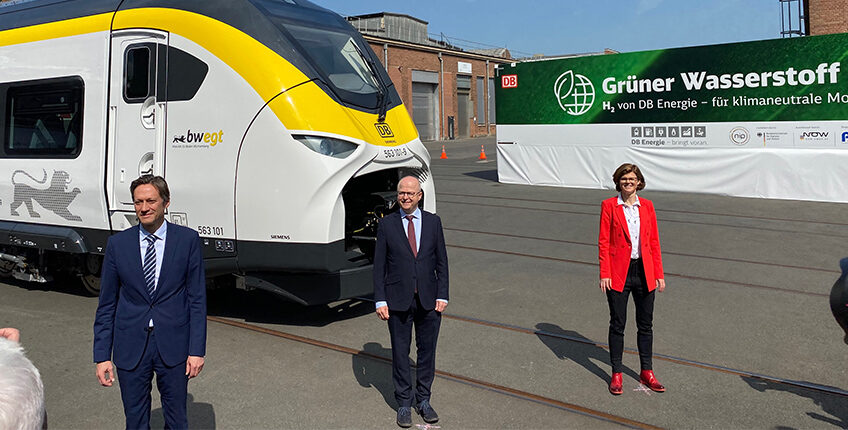The H2goesRail joint project is developing a completely new overall hydrogen system for rail transport – First rollout of the Mireo Plus H hydrogen train by Siemens Mobility and the hydrogen storage trailer for mobile hydrogen refuelling by Deutsche Bahn – Important step for phasing out diesel and switching to climate-friendly transport
Deutsche Bahn (DB) and Siemens Mobility are continuing to drive forward a climate-friendly revolution for rail transport. For the first time, both partners are presenting elements of the innovative overall hydrogen system at the Siemens manufacturing site in Krefeld: the newly developed Mireo Plus H, the latest generation of hydrogen train, and a newly designed mobility hydrogen storage trailer. The vehicle and the relevant infrastructure are to replace diesel multiple units in regional transport and reduce CO2 rail emissions to zero.
The H2goesRail project is being funded under the framework of the National Innovation Programme for Hydrogen and Fuel Cell Technology with a total of 13.74 million euros by the Federal Ministry for Digital and Transport (BMDV). The funding guideline is coordinated by NOW GmbH and implemented by Project Management Jülich (PtJ).
“Under the coalition agreement, the federal government agreed to electrify 75% of the rail network by 2030,” says Michael Theurer, Parliamentary State Secretary in the BMDV and Federal Government Commissioner for Rail Transport. “Alternative drives can help to reduce emissions from diesel rail transport. H2goesRail is the realisation of a project that not only tests the use of hydrogen for rail transport, but also majorly advances it. This allows us to also travel in a virtually climate-neutral manner on routes that are otherwise difficult to electrify.”
“We will only prevent climate change with a strong railway service. The Mireo Plus H facilitates climate-friendly and locally zero-emission passenger transport,” says Michael Peter, CEO of Siemens Mobility. “With the Mireo Plus H, we have developed the latest generation of hydrogen trains that enjoy a particularly long range and faster acceleration. Every train delivered can save up to 45,000 tonnes of CO2 over its service life of 30 years compared to the equivalent car journeys.”
“Hydrogen trains are an important building block for Deutsche Bahn on the path to climate neutrality,” says Dr. Daniela Gerd tom Markotten, Deutsche Bahn Board Member for Digitalisation and Technology. “Our development of the mobile hydrogen refuelling station and the accompanying maintenance infrastructure shows that our expertise lies not only in mobility, but in technology too. And this is precisely what is needed for tomorrow’s climate-friendly transport. H2goesRail and the collaboration with Siemens Mobility is therefore a significant step towards phasing out diesel and making our fleet green.”
The Mireo Plus H for the H2goesRail project has a range of up to 800km as a two-car, is as powerful as electric multiple units and features a high drive power of 1.7 MW for up to 1.1 m/s² acceleration, as well as a top speed of up to 160 km/h. A three-car variant has a range of 1,000 kilometres.
A key element of making hydrogen technology competitive in everyday operation compared to previously used diesel fuel is a faster refuelling process. DB therefore has developed a new type of process through which for the first time, the refuelling of a hydrogen train takes exactly the same amount of time as refuelling a diesel multiple unit. This is a critical aspect considering the closely timed train intervals in DB regional transport. The hydrogen is produced in Tübingen by DB Energie with green electricity that comes directly from the overhead line. For the purpose of train maintenance, the DB facility in Ulm will be equipped accordingly.
Hydrogen trains are a particularly climate-friendly drive technology, because they run on green hydrogen with zero emissions, only producing steam and no CO2. In the H2goesRail project for example, the route between Tübingen and Pforzheim yields a CO2 saving of 330 tonnes per year through eliminating diesel. In general, the Mireo Plus H, depending on the route profile, can save 520 tonnes per year (calculated on the basis of 200,000 km per annum).
The Mireo Plus H will begin test runs in 2023 in Baden-Württemberg. From 2024, it will be used for regular passenger service between Tübingen Horb and Pforzheim and replaces one of the diesel multiple units there.
Siemens Mobility and Deutsche Bahn will also present the H2goesRail project and the Mireo Plus H at InnoTrans 2022, the world’s largest trade fair for train technology in Berlin.
Project facts in detail:
The official name of the joint funding project is “H2goesRail”. The Federal Ministry of Digital and Transport (BMDV – Bundesministerium für Digitales und Verkehr) is supporting the project through the National Innovation Programme Hydrogen and Fuel Cell Technology (NIP 2) with more than 13 million euros in funding. NIP 2 is coordinated by the National Organisation Hydrogen and Fuel Cell Technology (NOW GmbH) and implemented by the Project Management Jülich (PtJ).
Hydrogen drives
Hydrogen drives with fuel cell technology produce electrical energy from the reaction of hydrogen and oxygen, with water as a “waste” byproduct. The implementation of such trains is a way for DB to become climate-neutral and to replace diesel vehicles with alternative propulsion systems. Green electricity is used to generate the environmentally friendly green hydrogen. DB Energie is responsible for supplying the hydrogen.
Mireo Plus H
For the one-year trial operation period, Siemens is developing a two-car regional train with a latest-generation hydrogen drive system. It consists of a fuel cell and a lithium-ion battery. The Mireo Plus H will be as powerful as electric multiple units and have a range of up to 800 kilometres – depending on operational conditions such as the season or the route. A three-car variant will have a range of 1000 kilometres. Low life-cycle costs due to low maintenance and servicing requirements and a top speed of 160 kilometres per hour are the vehicle’s distinguishing features.
Refuelling stations
DB is developing, testing and optimising the infrastructure required for the supply of hydrogen. The hydrogen is produced by electrolysis at the DB plant in Tübingen; the green electricity required for this comes directly from the overhead line. In the so-called electrolyser, water is split into hydrogen and oxygen with the help of green electricity. After being densified in a compressor, the hydrogen is stored in a mobile storage tank. Before refuelling, the green fuel is processed and cooled. The mobile set-up enables further test projects on routes that have not yet been connected.
Fast refuelling
The train is refuelled with hydrogen in an innovative new process: For the first time, this takes no longer than the refuelling of a diesel multiple unit. This is an important aspect in view of the closely timed train schedules in DB’s regional transport. This makes hydrogen technology competitive with the diesel fuel previously used in day-to-day operations.
Maintenance
The DB Regio workshop in Ulm will be converted for the maintenance of hydrogen multiple units. The maintenance of the hydrogen train can then be carried out there by fully trained DB Regio staff with the support of Siemens Mobility employees.
Passenger service
After a test phase, the train will be in passenger service between Tübingen, Horb and Pforzheim for one year from 2024. Around 120,000 kilometres of scheduled rail operation are planned. The route is particularly suitable because of the timetable’s intervals, which are exemplary for regional transport, and the varied topography. The Mireo Plus H from Siemens will replace a diesel railcar usually used on this route and will save about 330 tonnes of carbon emissions. Special training will be provided for the drivers, who will operate the train on a trial basis.


